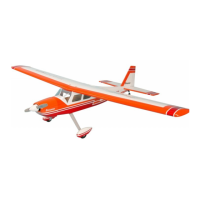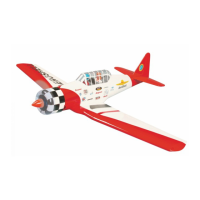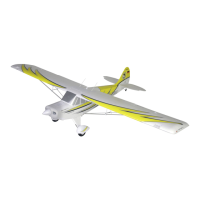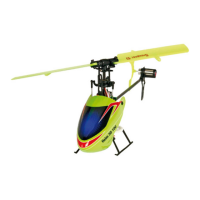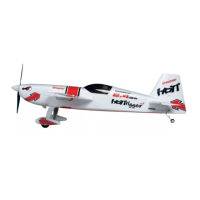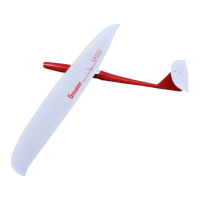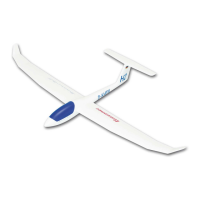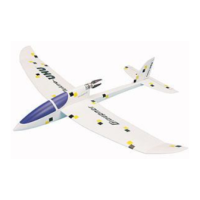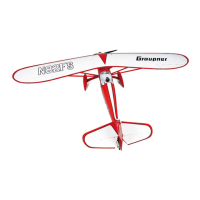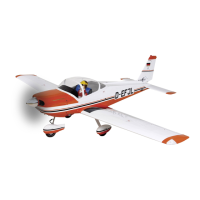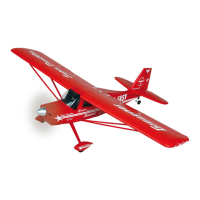GRAUPNER GmbH & Co. KG D-73230 KIRCHHEIM/TECK GERMANY
Änderungen vorbehalten! Keine Haftung für Druckfehler! Ident-Nr. 0057999
Made in Thailand
04/2003
65
65
Thrust vectoring pipe, pivot bearings
− Mark the position of the pivot axis of the thrust vectoring pipe as shown in (Fig. 10) using a pencil and
ruler. Hold the ruler above and below the turbine support plate to mark this point. Set slide callipers to 22
mm and use them to score the fuselage lightly in the area of the pencil marks through the fuselage opening,
working from the rear (Fig. 10a).
− Push a stout pin through the inside of the fuselage at the marked points.
− Open up the holes to 4 mm Ø working from the outside.
− Position the pivot bearing discs (No. 8) over the holes and tack them in place with cyano. Reinforce the
joints with thickened epoxy resin and glass cloth (No. 30) (Fig. 10c). Fit the brass tube (No. 53) through
both discs to align them accurately.
− Attach the aluminium bearing components to the thrust vectoring pipe using the screws (No. 10), and
secure the screws with thread-lock fluid (Fig. 11a).
− Screw the ball-link (No. 60) to the thrust vectoring pipe actuating lug and secure it with the M2 self-locking
nut (No. 61) (Fig. 11a).
− Secure the thrust vectoring pipe from the outside using M3 x 8 screws (No. 10), as described above. You
may need to countersink the outside skin of the fuselage to provide freedom of movement (Fig. 11b).
− General tip: before you make up any of the control surface linkages, check carefully that the servos are at
neutral / centre, and that the servo output arms are correctly positioned, i.e. at 90º to the servo case. The
output arm retaining screws must be properly fitted and adequately tightened. If the pushrods are straight,
and perfectly aligned with the servos and the control surfaces, you will find it straightforward to program
the radio control system satisfactorily. We strongly recommend using the Graupner Servo Tester, Order
No. 763, to centre the servos accurately and check and adjust the control surface travels.
Thrust vectoring servo
− Mount the servo on the plywood plate (No. 26) using the sheet metal holder (No. 62) and associated small
parts (No. 63, 64, 65, 66) as shown in (Figs. 12, 12a). Glue the whole assembly to the fuselage side,
positioned as shown in (Fig. 12a), using thickened epoxy resin or UHU plus endfest 300, and reinforce the
joints with glass cloth (No. 30).
− Make up the pushrod from parts (No. 52, 53, 56, 57, 59), as shown in (Figs. 13, 13a).
− Be sure to secure all screwed joints with Loctite thread-lock fluid!
Wings (Servo-Locks, pushrods, horns)
- The first step here is to assemble the Servo-Locks from the machined plywood parts (No. 22) using thick
cyano. Screw the servos to the mounts (Fig. 14).
- The servos can now be installed.
- Position the servo assembly correctly relative to the machined slot in the hatch cover (Fig. 14a), then glue
the Servo-Lock cover to the assembled Servo-Lock using thick cyano. Before you glue the parts together
it is important to check that each servo is positioned with the output arm aligned accurately with the
machined slot in the top surface of the wing, and with the machined horn slot in the control surface
(Figs. 14a, 14b). If necessary adjust the machined slot in the top surface of the wing using a round file (Fig.
14b).
- Screw the Servo-Locks to the wings using the self-tapping screws (No. 14, 16 off). Drill 1.5 mm Ø pilot-
holes beforehand to avoid the plywood splitting or bursting. Don’t forget to extend the servo leads and
secure the connections. Set the servos to centre (neutral) using a servo tester and fit the servo output arms.
Secure them permanently at this point using the screws provided - this saves removing and re-installing the
servos repeatedly.
- Glue the control surface horns (No. 15) in the machined slots in the control surfaces (Fig. 14b), using the
template included in the kit to position them accurately. Use only UHU plus endfest 300 for these joints,
and sand the horns thoroughly before installing them.
- Ensure that the horns (No. 15) are shortened and trimmed as shown, and are fitted full-depth into their slots.
- The pushrods for the four elevons are assembled using the M3 clevises (No. 55), locknuts (No. 58) and
threaded rods (No. 51), cutting each to the required length for its control surface. The clevises can also be
soldered to the rods if you prefer (Fig. 14b), as an alternative to securing them with M3 nuts (No. 3).
- The linkage hole must be located approximately in line with the front edge of the horn gap of the control
surface.
- General tip: before you make up any of the control surface linkages, check carefully that the servos are at
neutral / centre, and that the servo output arms are correctly positioned. The output arm retaining screws
must be properly fitted and adequately tightened. If the pushrods are straight, and perfectly aligned with the
servos and the control surfaces, you will find it straightforward to program the radio control system
satisfactorily. We strongly recommend using the Graupner Servo Tester, Order No. 763, to centre the servos
accurately and check and adjust the control surface travels.
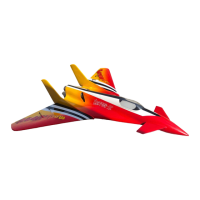
